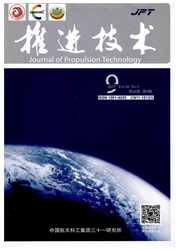

 中文摘要:
中文摘要:
针对风洞实验观测高超声速内转式进气道内部流动困难,不易获得内流道三维激波/边界层干扰主导的复杂流场结构的问题,通过拓展壁面丝线流动显示技术的潜力,在Ma∞5.9激波风洞中,借助高速摄影实时拍摄丝线流谱,并结合纹影、壁面压强测量以及数值模拟分析,验证了丝线的动态响应特性,丰富了内转式进气道的观测技术,获得了进气道的流场结构。采用预设堵块实验方法,在激波风洞中考核了内转式进气道模型的自起动能力。结果表明,直径约为0.1 mm,长度约为15 mm的402号涤纶/棉缝纫线的跟随性较好,能够直观、动态地显示出壁面流动分离区的范围,为判断内转式进气道是否起动提供了依据。内转式进气道模型在实验条件下能够自起动,起动状态下进气道唇口附近的波系结构以及前体压缩面的丝线流谱和压力分布与数值模拟符合较好。
 英文摘要:
英文摘要:
Due to the difficulty in observing the internal flow of a hypersonic inward-turning inlet in wind tunnels,the flow structure of the three-dimensional shock wave/boundary layer interactions in such an inwardturning inlet cannot be obtained easily. The surface tuft flow visualization technique was extended,and then applied in a shock tunnel with a freestream Mach number of 5.9 to obtain the flow structure in an inward-turning inlet. With the help of a high-speed camera to monitor flow patterns of the surface tuft in real time,Schlieren associated with surface pressure measurement and analysis of numerical simulations and the dynamic response characteristics of the tuft was confirmed. The surface tuft flow visualization technique enriches the observation methods of the inward-turning inlet. To detect the inlet self-starting ability in the shock tunnel,a testing method of presetting a blockage in the inlet was used. The results indicate that the tuft of 402 polyester cotton sewing thread with a diameter of approximately 0.1mm and a length of approximately 15 mm has fast tracking ability to intuitively and dynamically display the flow separation region on the inlet wall,which is proof of its good ability to indicate the start/unstart of the inward-turning inlet. The inward-turning inlet model is able to self-start at the test flow conditions. When the inlet is started,the shock structure near the cowl,the surface tuft flow patterns and the pressure distribution on the forebody agree well with the numerical simulations.
 同期刊论文项目
同期刊论文项目
 同项目期刊论文
同项目期刊论文
 期刊信息
期刊信息
